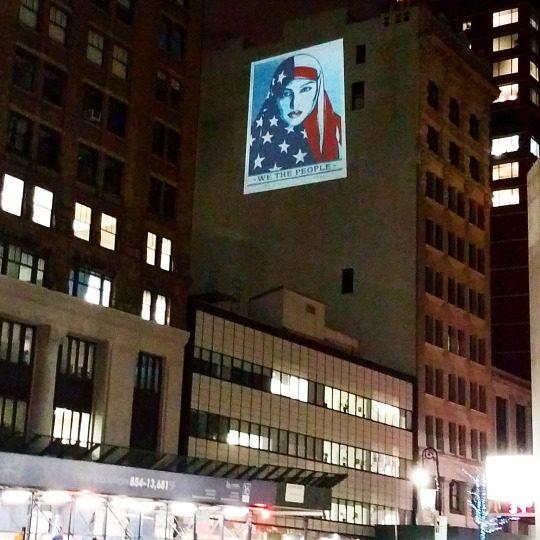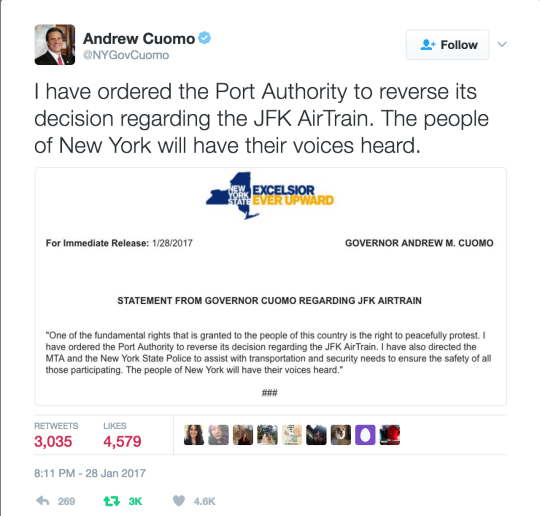via
http://ift.tt/2kG2Flo:
lettersfromtitan:
brigdh:
I was in the courtroom tonight at the Federal Court of Brooklyn. I am not a lawyer or anything, but I took notes, and here’s what it was like.
We happened to see the call on twitter asking for people to arrive at the Cadman Plaza out front of the courthouse by 7:30 pm. We were near enough to make it, so we hopped on a subway and rode a few stops to arrive by 7:20 or so. There were about 100 people already in the plaza, chanting, making signs, and singing. Around 8 they started to let people into the building in small groups of 10 to go through security and make sure they didn’t overflow the courtroom. I didn’t think we’d make it in, but after the first few groups of ten they opened a second door right next to us. I’d estimate 60-70 people actually got into the audience of the courtroom, which was as much as it could hold. We were pretty squished on the bench trying to make more room.
In the courtroom itself, there was one lawyer for the ACLU and two present for the government: a black woman from the Attorney General and a Jewish man from the Department of Immigration (I have no idea what their personal views were on the situation). There was an additional government lawyer on the phone.
The ACLU had filed on behalf of two named people, both of whom had arrived in JFK and been detained, and the larger class of all people affected by the Executive Order. The government pointed out that both of the named people had in fact already been released and so the case was moot, but the ACLU insisted that they had only named two people because the government was refusing to release the names of any others. The ACLU and the judge (Ann M. Donnelly) insisted that they needed to deal with the larger class, even if these two specific people were no longer being detained.
The ACLU asked for an assurance that “future plaintives” wouldn’t be removed from the country. The government said they couldn’t make those assurances without knowing specifics about the “arriving aliens”.
The judge said that she was following Supreme Court precedent, which depended on the “four factor test”, the most important of which in this situation was the potential for irreparable harm to the people being detained. (The others were the likelihood of injury to the petitioner, the public good, and a fourth I didn’t catch.) She asked the government specifically, “What is your argument that there won’t be irreparable injury?”
The government replied that they couldn’t say without named petitioners.
The judge pointed out that all the people being detained have been through an extensive vetting process already, some for years. Again she said, “Explain to me how it is that members of this class will not suffer irreparable injury.”
The government lawyers said that was an “overly broad request”.
The judge said that she saw no likelihood of injury to the opposing party (ie, the government), because all of these people would have been allowed in the country two days ago without problem. She said given that, and the “likelihood of success on the merits of the case” that she granted the stay (that is, no people currently being detained under the executive order could be sent out of the US). She also said, “I think the government hasn’t had a full chance to think about this.” And that was very obviously true, as the government’s lawyers repeatedly weren’t able to answer questions or predict what would happen next.
They began to set a date for the next hearing, and the government lawyers said they would need at least two weeks to prepare. The ACLU lawyer said that two weeks was a long time to keep people in detention without knowing what would happen to them. The government lawyers agreed, but couldn’t say if it was likely they would continue to keep people in detention or not.
The ACLU lawyer asked for a list of everyone currently being detained, since they didn’t even have accurate numbers of how many people it was (though he guessed 100-200 people).
The government lawyers replied that was “more difficult that it sounds”. !!!!
The judge said, “Why don’t you work it out.” You could hear her trying hard to suppress her eye roll. She then said that the whole point of this stay was to maintain the status quo, and that “it was not unduly burdensome to identify the people in the stated class”.
The eventual dates they settled on for the future was: Feb 10 for the government to file papers. The ACLU said they could respond within 48 hours. The government asked for a further seven days to prepare a respond to that, with the next hearing to take place on Feb 21.
(And what we saw when we came out of the courthouse)
TL;DR – the stay was granted! No one is being kicked out of the US right now! It applies nationwide! :D
Unfortunately only temporary and the ultimate fate of this people is yet to be decided. It also only covers people already in the US or who were in transit at the time of the ruling. :(
I am the other part of the we that was there; I am also not a lawyer. The fourth condition for granting the stay is what was likely to happen to the case when ultimately decided on the merits. Basically, the ACLU has a reasonable case so it made sense to ask for a stay.
The judge’s tone throughout was kind, patient (aware the gov’t lawyers were in a bad position) but clearly completely revolted by the EO and the lack of preparation on the gov’t side. She underscored that yes, obviously, the people in the class were obvious at threat of irreparable harm. She was deeply snide when the gov’t tried to avoid questions to this effect.
Also of note,ACLU was like “we can respond to anything you need us to within 48 hours” and the gov’t people were like “we need weeks.”
When we left the court room, we all had to get our phones back out of the check in the lobby, and we were held together as a group until we were released outside (court staff and security were super kind and cheerful with us, btw at all points in the interaction). As we walked towards the glass front of the building with our thumbs up everyone started cheering madly outside. They made a corridor of cheering people for us to exit through and everyone was patting the people out on the back. I have never experienced a crowd like that in my life (and I’m a performer). It was overwhelming, hard not to cry, very beautiful, and we hadn’t done anything but be the people who were able to get there and show the court that the world was watching. It was beautiful and gave me hope after a pretty dire 24 hours.
I also want to note that protesters were great throughout at making sure lawyers and press got in, silencing the crowd for announcements, etc. Over the course of the event I found out that people outside included my Tremontaine S2 cowriter, my old roommate, my ex and his wife, and an old friend Livejournal.
As Brigdh notes, we only got to this because we saw a tweet and were in the area. Protest is the new weather. If you’re potentially able to go, dress for it. Good shoes, warm clothes, granola bars in purse.
















